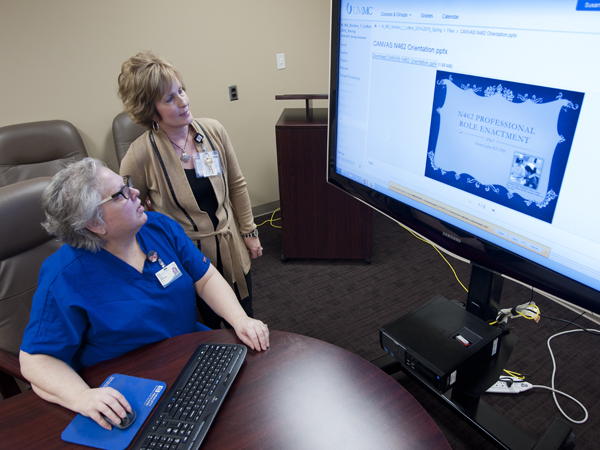Canvas, yes; Blackboard, no: Software switch looms

Published in News Stories on January 26, 2015
Blackboard is about to be erased.
The Learning Management System (LMS) used by nearly 3,000 Medical Center students and faculty for course content, quizzes, messaging and more will be rubbed out in favor of a similar product called Canvas – a switch scheduled for completion by semester’s end, said David Fowler, chief institutional research officer.
Pioneering this project are about 200-300 students in the School of Nursing; enrolled in the online RN-to-BSN bridge program, they have been immersed in Canvas here since the semester began.

Fowler
“That was a godsend,” Fowler said. “They’ll work through the bugs and make sure it works properly.”
Many UMMC students – particularly those arriving here from community colleges – were already wrapped up in Canvas before enrolling at UMMC, Fowler said. That was one reason for the swap.
“However, change is not something people like a whole lot, usually. We’re trying to make it as painless as possible.”
May 26, the start of the summer semester, is the target date for the campus-wide Canvas conversion. Those affected – current Blackboard users – number about 2,900, including students, residents and fellows.
“Faculty members are not required to use it, but most do,” Fowler said. “Some still prefer blackboard and chalk.”
All courses in Blackboard will have to be transferred to Canvas, which has a mechanism for that, Fowler said. After the changeover, faculty will still have access to courses through Blackboard until July 1; and once that system turns off, documents and other materials can still be retrieved through an archive drive, Fowler said.
“Faculty can archive their own courses on computers here. There’s a free online site where you can load the course and pull whatever you need from it.”
To abet the transition, online training sessions lined up for students and faculty will be tailored to each school’s needs. Tutorials are already in place for the School of Nursing and the School of Health Related Professions and face-to-face training has begun in the Schools of Medicine and Dentistry, Fowler said.
As a teaching-learning tool, Blackboard Learn has served UMMC well for around 15 years, Fowler said. But about a year ago, the institution began scrutinizing other similar software, including Canvas, a product of the Utah-based educational technology company, Instructure.
“Canvas has all the functions and provisions of Blackboard Learn, and more,” Fowler said. “More importantly, it appears to be much more intuitive than other systems I’ve seen.”
Nursing student Charlotte Floyd of Byram has navigated both – Blackboard first in high school and then Canvas for more than two years at Holmes Community College in Ridgeland before enrolling in the RN-to-BSN program here.
“I like Canvas a little better,” said Floyd, who will earn her BSN in May. “It’s more user-friendly, more self-explanatory. I never had any problems with it.”
To oversee the Canvas coup campus-wide, Fowler and other administrators created the eCampus Office and assembled an advisory group representing the Office of Academic Affairs, the Division of Information Systems (DIS) and the schools of dentistry, graduate studies, health-related professions, nursing and medicine.
Among the institutions that have recently adopted Canvas is the University of Alabama-Birmingham, which projected in 2013 a net savings each year of more than $150,000.
Thrift played a role at UMMC as well. “Canvas costs less than half of what we were paying for Blackboard,” Fowler said.
With support from the vice chancellors’ office, Dr. Ralph Didlake, associate vice chancellor for academic affairs and chief academic officer, made the final decision to embrace Canvas after it was approved by the five schools’ faculty representatives, Fowler said.

Pruett
Dr. Christian Pruett, for one, hailed the choice. “Blackboard is a great Learning Management System, but Canvas is a lot easier for students to use,” said Pruett, an assistant professor in the School of Nursing, where he is also director of instructional development and distance learning.
The RN-to-BSN program seemed like a good place to start, he said. “Because the students work completely online, they are the best to try it. Because of the graciousness of Dr. Lofton, we are piloting it.”
Dr. Susan Lofton, professor of instruction in the School of Nursing, assigned her students the Medical Center’s trail-blazing role.
“Most of them had already taken Canvas courses,” she said. “I have not met one student who prefers Blackboard to Canvas.”
Although compliance training, too, will eventually shift to Canvas as well, Blackboard will not be wiped clean out of UMMC’s life, at least for now. Blackboard Learn is just one product of Blackboard Inc., based in the Washington, D.C. area.
Another, Blackboard Collaborate, will still operate here for an indefinite period as a class-interaction tool wielded for web conferencing, instant messaging and more.
But SafeAssign, Blackboard Learn’s anti-plagiarism product, will disappear. “We’re looking for a substitute,” Fowler said.
Another change: Respondus, a testing system whose partners include Blackboard and Canvas, will remain, but Exam Soft, with more student-assessment features, will be the preferred software at UMMC, Fowler said.
“The main thing to remember about the changes is that students and faculty will have help in getting this done.
“So there’s no interruption in courses, we’re going to walk them through it, and try to meet all their needs.”


